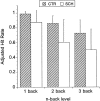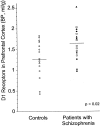Prefrontal dopamine D1 receptors and working memory in schizophrenia
- PMID: 11978847
- PMCID: PMC6758376
- DOI: 10.1523/JNEUROSCI.22-09-03708.2002
Prefrontal dopamine D1 receptors and working memory in schizophrenia
Abstract
Studies in nonhuman primates documented that appropriate stimulation of dopamine (DA) D1 receptors in the dorsolateral prefrontal cortex (DLPFC) is critical for working memory processing. The defective ability of patients with schizophrenia at working memory tasks is a core feature of this illness. It has been postulated that this impairment relates to a deficiency in mesocortical DA function. In this study, D1 receptor availability was measured with positron emission tomography and the selective D1 receptor antagonist [11C]NNC 112 in 16 patients with schizophrenia (seven drug-naive and nine drug-free patients) and 16 matched healthy controls. [11C]NNC 112 binding potential (BP) was significantly elevated in the DLPFC of patients with schizophrenia (1.63 +/- 0.39 ml/gm) compared with control subjects (1.27 +/- 0.44 ml/gm; p = 0.02). In patients with schizophrenia, increased DLPFC [11C]NNC 112 BP was a strong predictor of poor performance at the n-back task, a test of working memory. These findings confirm that alteration of DLPFC D1 receptor transmission is involved in working memory deficits presented by patients with schizophrenia. Increased D1 receptor availability observed in patients with schizophrenia might represent a compensatory (but ineffective) upregulation secondary to sustained deficiency in mesocortical DA function.
Figures







References
-
- Abi-Dargham A, Laruelle M, Seibyl J, Rattner Z, Baldwin RM, Zoghbi SS, Zea-Ponce Y, Bremner JD, Hyde TM, Charney DS, Hoffer PB, Innis RB. SPECT measurement of benzodiazepine receptors in human brain with [123-I]iomazenil: kinetic and equilibrium paradigms. J Nucl Med. 1994;35:228–238. - PubMed
-
- Abi-Dargham A, Simpson N, Kegeles L, Parsey R, Hwang DR, Anjilvel S, Zea-Ponce Y, Lombardo I, Van Heertum R, Mann JJ, Foged C, Halldin C, Laruelle M. PET studies of binding competition between endogenous dopamine and the D1 radiotracer [11C]NNC 756. Synapse. 1999;32:93–109. - PubMed
-
- Abi-Dargham A, Martinez D, Mawlawi O, Simpson N, Hwang DR, Slifstein M, Anjilvel S, Pidcock J, Guo NN, Lombardo I, Mann JJ, Van Heertum R, Foged C, Halldin C, Laruelle M. Measurement of striatal and extrastriatal dopamine D1 receptor binding potential with [11C]NNC 112 in humans: validation and reproducibility. J Cereb Blood Flow Metab. 2000;20:225–243. - PubMed
-
- Akil M, Pierri JN, Whitehead RE, Edgar CL, Mohila C, Sampson AR, Lewis DA. Lamina-specific alterations in the dopamine innervation of the prefrontal cortex in schizophrenic subjects. Am J Psychiatry. 1999;156:1580–1589. - PubMed
-
- Andersen PH, Gronvald FC, Hohlweg R, Hansen LB, Guddal E, Braestrup C, Nielsen EB. NNC-112, NNC-687 and NNC-756, new selective and highly potent dopamine D1 receptor antagonists. Eur J Pharmacol. 1992;219:45–52. - PubMed
Publication types
MeSH terms
Substances
Grants and funding
LinkOut - more resources
Full Text Sources
Other Literature Sources
Medical
